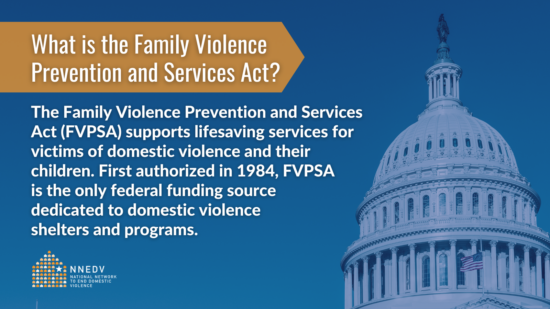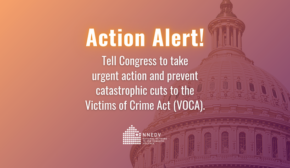Family Violence Prevention and Services Act
The Family Violence Prevention and Services Act (FVPSA) supports lifesaving services for victims of domestic violence and their children, including emergency shelters, crisis hotlines, counseling, and programs for underserved communities throughout the United States, American Indian and Alaska Native communities, and territories. First authorized in 1984 and administered by the U.S. Department of Health and Human Services, FVPSA is the only federal funding source dedicated to domestic violence shelters and programs.

Over 1,500 local domestic violence programs rely on FVPSA funding to keep their doors open to more than 1.3 million victims seeking safety each year. A multi-state study, funded by the National Institute of Justice, shows conclusively that the nation’s domestic violence shelters are addressing both the urgent safety needs of victims and their long-term needs, including economic stability. NNEDV’s Annual Domestic Violence Counts Report finds that, in just one day each year, tens of thousands of adults and children receive desperately needed services from local domestic violence programs. Tragically, thousands more are turned away because programs simply do not have the resources to meet their needs.
Despite FVPSA’s great promise, it is clear that community-based domestic violence programs cannot meet the overwhelming demand for services without additional resources.
FVPSA Funding
There is an unconscionable gap between desperate need and available resources. Increased federal investment in domestic violence programs is needed to ensure that local programs can help all survivors who reach out for help. We urge Congress to fund FVPSA at $500 million.
FVPSA Reauthorization
FVPSA expired in 2015 and must be reauthorized with key improvements.
The U.S. House of Representatives reintroduced the bipartisan Family Violence Prevention and Services Improvement Act (FVPSA Improvement) on April 13, 2023. The FVPSA Improvement Act includes key enhancements to increase the funding authorization level, expand support for and access to culturally specific programs, strengthen the capacity of Indian tribes, and meaningfully invest in prevention, among other enhancements. The National Network to End Domestic Violence (NNEDV) applauds the bill’s lead sponsors, Representatives Lucy McBath (D-GA), Brian Fitzpatrick (R-PA), Gwen Moore (D-WI), and Young Kim (R-CA) for their leadership. Similar bills (H.R. 2119 and S. 1275) were passed by the House of Representatives and passed out of the Senate Health Education Labor and Pensions (HELP) committee in the last Congress. .
Domestic Violence Prevention Enhancement and Leadership Through Alliances (DELTA) Impact Program
The CDC’s Domestic Violence Prevention Enhancement and Leadership Through Alliances (DELTA) Impact program funds state domestic violence coalitions to implement strategies and approaches designed to prevent intimate partner violence while also funding local communities to do the same. The purpose of DELTA Impact is to decrease risk factors in communities that may lead to intimate partner violence and to increase protective factors that prevent it. Funded state domestic violence coalitions and their local Coordinated Community Response Teams affect these factors by implementing programs and policies. Learn more from the CDC here.
FVPSA enhancements that support DELTA grants are designed to increase primary prevention capacity at the state, tribal, territory, and local levels while continuing to build evidence for effective multi-faceted prevention approaches that reduce and end domestic violence.
Resources:





